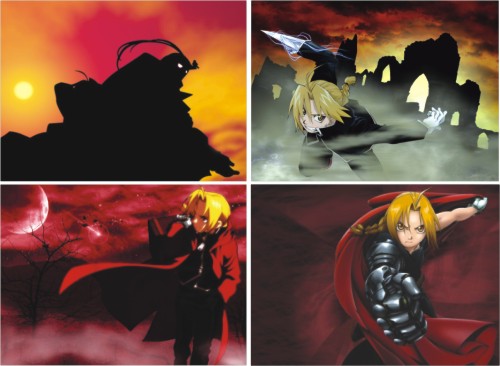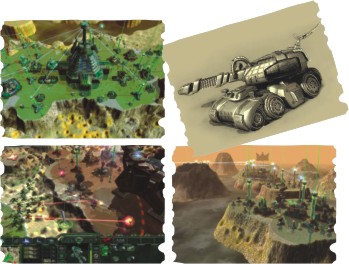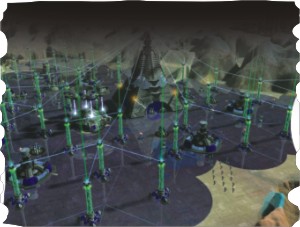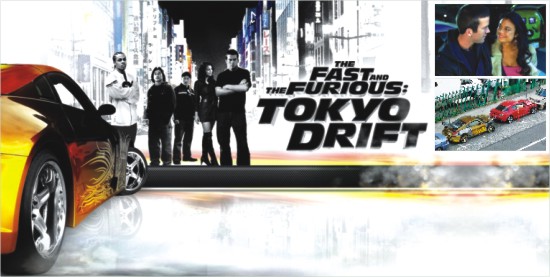
Fullmetal Alchemist is the shocking, emotional journey of the two Elric brothers who broke forbidden ground when attempting to revive their dead mother through the powers of Alchemy. As a result, Ed loses his arm and his leg, while Al's soul is bound to a suit of armour. Now the brothers begin their search for the Legendary Philosopher's Stone whose power will allow them to set things right…
Now, I know Lancer has already reviewed this but since they're showing it on Animax, I thought I'd leave my review as a tribute to anime fans all over Bangladesh before I fly off abroad.
I started watching FMA without knowing what I was getting into no hype, no rants, no recommendation, nothing. And I was suitably blown away…
The true beauty of FMA lies in its character cast. Each individual is utterly compelling and truly gives off an aura of being; they're such real people. It's quite easy to connect to them on an emotional level and relate to their thoughts, comments and aspirations. Their interactions are genuine in the way they confide in, spar with and avoid each other in the appropriate situations. In fact, these characters are no different from you or me: they can be selfish; they live for their dreams and stop at nothing to achieve them. All of them are developed beautifully and in the end, you will feel like you were travelling alongside the Elric brothers on their journey of retribution.
The story itself is deep, poignant and dark; it's a poetic tale of loss, consequence, and life. FMA truly appreciates the melding of the blacks and whites of the world into numerous shades of grey. There are no heroes or villains here only real people.

There are subtle messages in every facet and mesmeric twists that'll leave you spellbound. FMA gains momentum with every chapter and the last ten episodes will leave you breathless due to the brutal rapidity with which the events unfold; it's simply brilliance incarnate. Alchemy itself is portrayed in a way that gives it depth and character. And lastly, FMA is a fantastic perspective of life from the eyes of two children.
The dialogue is extremely well-written and there is nary a plot-hole in sight. Everything is explained beautifully within the limits of the world that FMA has created and that only heightens the sense of realism. The comedy is also good stuff that warms the heart. Even the few fight scenes are great because of the way they are presented.
The artwork is a beautiful thing to behind; the use of bright, vibrant imagery contrasts marvellously with the darker scenarios. The animation flows lusciously, making FMA a true visual treat. CGI is used with every subtlety and enhances the scenarios without making one realise it's being used at all.
The voice acting in FMA is quality stuff, both the English and Japanese versions. The respective voice actors really give life to their characters and the way they play off each other is amusing to watch (or hear). The music is truly memorable. It's soul stirring and sombre yet light-hearted and flippant when it needs to be. The intro themes (four of them) are fantastically catchy J-pop themes whose exclusion in the English version is a severe oversight on Animax's part. The outro songs are also great. Truly unforgettable is the way that the second one ('Tobira no Mukou he') segues from the ending scene into the song itself. In my opinion, it's the definitive ending theme!
There are things that people will nitpick about, but I am not they. For the sake of parity, the story can threaten to confuse casual viewers and some comedic moments don't gel. That's all, folks.
In the end, I love FMA. It's definitely my favourite anime and you could accuse me of bias because of that. However, put your scepticism aside and you'll find an unforgettable, engrossing and emotional viewing experience like no other.

 Seeing as Perimeter was one of the most innovative real-time strategy games to come down the pike in some time, you would expect it to spawn a radical expansion pack or sequel. The original game is filled with out-there touches such as a bizarre plot featuring sponge worlds that can be bulldozed however you see fit and nanotech units that morph like pint-sized Transformers. While Emperor's Testament is another solid, supremely strange RTS, Russian developer K-D Lab has stuck to the template of the 2004 original and made it a straightforward expansion. This is one of those don't-fix-it-if-it-ain't-broken add-ons that builds on the old story, themes, and settings. The game is a collection of new maps and missions that stretch the original campaign in a new direction, so only fans of the first game need apply.
Seeing as Perimeter was one of the most innovative real-time strategy games to come down the pike in some time, you would expect it to spawn a radical expansion pack or sequel. The original game is filled with out-there touches such as a bizarre plot featuring sponge worlds that can be bulldozed however you see fit and nanotech units that morph like pint-sized Transformers. While Emperor's Testament is another solid, supremely strange RTS, Russian developer K-D Lab has stuck to the template of the 2004 original and made it a straightforward expansion. This is one of those don't-fix-it-if-it-ain't-broken add-ons that builds on the old story, themes, and settings. The game is a collection of new maps and missions that stretch the original campaign in a new direction, so only fans of the first game need apply.
It feels like you're picking up where you left off, too. K-D Lab assumes that you have no small experience with the original Perimeter, as you aren't eased into the wacked-out goodness with an in-game tutorial or a step-by-step primer in the manual. Instead, you kick off the roughly two-dozen-mission campaign with disjointed opening cinematics and an incomprehensible briefing from the eponymous emperor about why you're working as a slave to help him conquer the sponge. But even though the plot and setting are calculated to make your head spin, the game itself remains focused because of its innovations.
Just like in the original Perimeter, the headlining innovation here is the ability to terraform map terrain in real time. Unlike the hills and mountains in other 3D RTS games, physical features here are routinely flattened to construct energy cores needed to generate the game's lone resource (which, unsurprisingly enough, is energy) and spread your base across the sponge. You can even carve up the terrain with moatlike defensive ditches. Though this is undeniably nifty, terraforming feels a bit gimmicky, as the terrain in each map is laid out so that there are just a few key locations where it makes sense to level the ground or dig ditches. This gives missions a strong puzzle vibe and forces you to figure out what the scenario designers require before committing to a course of action. Unfortunately, it isn't effective to tear up the turf wherever and whenever you feel like some impromptu landscaping will improve your odds against enemy forces.
Because of this limitation, you need to learn maps instead of dealing with them on the fly as tactical challenges. Missions play so fast and so tough from the beginning of the game (which means, again, that familiarity with the original Perimeter is a necessity before diving into this new campaign) that you typically need to experiment to see how the enemy will attack or, at the least, mess around with a mission for a few minutes to get your bearings before hitting restart. Only after doing this will you gain an idea of where you need to dig ditches and establish choke points, what areas you need to level to extend your energy-collection system, where the best spots are to build defensive laser cannons, and so forth.
 Unit management, however, makes it easy to forgive the somewhat limited, puzzle-heavy mission design. Rather than the standard RTS formula of building custom facilities with which to crank out axemen, commandos, tanks, and the like, here you build only three types of units--soldiers, officers, and technicians--and then create labs that let you glom them together into bigger and better units, such as tanks and fighter aircraft. This feature really opens up strategic and tactical options, as you can completely transform your army on the fly to address whatever the enemy throws at you. Snipers getting blasted by enemy howitzers? Change them to high-flying ceptor choppers with the click of a mouse. Enemy countering your ceptors? Go back to the ground and turn them into mortars.
Unit management, however, makes it easy to forgive the somewhat limited, puzzle-heavy mission design. Rather than the standard RTS formula of building custom facilities with which to crank out axemen, commandos, tanks, and the like, here you build only three types of units--soldiers, officers, and technicians--and then create labs that let you glom them together into bigger and better units, such as tanks and fighter aircraft. This feature really opens up strategic and tactical options, as you can completely transform your army on the fly to address whatever the enemy throws at you. Snipers getting blasted by enemy howitzers? Change them to high-flying ceptor choppers with the click of a mouse. Enemy countering your ceptors? Go back to the ground and turn them into mortars.
The big drawback to the gameplay here is that you've seen it all before. Emperor's Testament holds no surprises for Perimeter veterans. Units are virtually identical to those in the original game. Missions are all retreads, with goals and settings that will give you déjà vu. Multiplayer features just three maps, and since there is no matching service (the manual claims that the game comes with third-party software support, but there is no evidence of this in the game itself), you need to know the IP addresses of opponents.
Also, this expansion is out of step with the times. It uses the stock Perimeter engine, which looked great in early 2004 but looks rather jaggy in the second half of 2006. The sponge worlds still look great, though, with a slightly icky, organic appearance that reminds you of mold viewed under a microscope. Sound effects seem to date back even further than two years. Battle rat-a-tats and booms are tinny, many vocal samples are plagued with cheesy synth effects, and the music is based on a revved-up techno beat more suitable to a mid-'90s sim than a mid-'00s RTS.
So, second verse, same as the first. Perimeter: Emperor's Testament has the same appealing, if decidedly peculiar, blend of RTS convention and innovation, although veterans of the first game might find things a bit too familiar here. Still, it's only $20, so the price is right if you like weirded-out real-time strategy.
The Fast and the Furious - Tokyo Drift
I Guess it is not only Hindi and Bangla movies where actors play below their ages. Apparently Hollywood also has older actors trying to be school kids. For starters we have a bunch of characters form the latest Fast and the Furious film where all the big (or mid) name stars seems to range from 20-30. While all students are said to be 17, it's known from hi bio that Lucas Black is 24.
But that age discrepancy aside the rest of the material in the movie fit in quite nicely.
The plot:
Sean (Lucas Black) manages to wreck a construction site during a car race on U.S. soil. Judge offers him the choice between Juvenile Hall or to go live with his father in Japan. Next scene we are taken straight to Japan where Sean is wearing a school uniform and replacing his shoes with slippers before entering a classroom. He doesn't know how to read, speak or do anything Japanese except maybe grunt. But apparently he will learn and besides everyone in Japan seems to be speaking very fluently in English so there should not be any problem at least in the movie.

Fast cars and girls go hand in hand. The first thing to take place after seeing fast cars is to see a girl that makes the heart run fast. That's what happens to Sean when he sees the beautiful Neela (Nathalie Kelley) sitting in the front row of the classroom. After only one day in school, Sean is offered a customized car to race down the ramps of a parking garage against the malevolent D.K. (Brian Tee). Bad news is that D.K. turns out is Neela's boyfriend. Worse news is that D. K.'s uncle is the Yakuza (the Japanese Mafia) boss Kamata (Sonny Chiba). Sad news is that in real life no one loans out their souped up cars to me.
The kids are all very rich it seems as after Sean wrecks the red RX8 that Han (Sung Kang) has loaned him, he still has more cars supplied to him like we have chewing gum supplied to us by friends. We can tell Han likes him despite Sean being a 'gaijin' or an outsider. Come to think of it if Sean crashes so much maybe he isn't that good a driver after all.
"I have money," Han tells Sean after the first crash. "It's trust I don't have." He lets Sean work off the cost of the car by walking into a bathhouse and trying to collect a debt from a sumo wrestler. Adding to his small group of friends is Twinkie (Bow Wow), who manages to find the coolest sneakers even before they end up on the market.
In the meantime Seans father (Brian Goodman), a U.S. military officer, gives the 'kid' the usual Hollywood movie rant about life not being a game and how the kid has to live under the fathers rules if he wants to live under the same roof. Nothing new there. You see the movie is not big on dialogue but it delivers enough everywhere else to keep it interesting and the action flowing.
The verdict:
"The Fast and the Furious: Tokyo Drift" is the third of the in this franchise. The racing scenes in the movie are fast and furious as the name suggests. The whole racing aspect is based on a technique called drifting that involves sliding sideways while braking and accelerating. The acting is excellent because the actors really don't have to do much acting here so it takes very little effort on their part. Basically they have to pose and look cool which some of them can do very well.
The movie is all about mostly wonderful cars And a great location. All of it is connected by throwing in a romance angle, a lot of rivalry and some comic timing with the punch lines. And yes, an interesting cameo at the end. And once again, a classic Mustang stars alongside the live actors.
What's interesting is the way the movie highlights details of Japanese life, instead of simply using Tokyo as an exotic location. We meet the sumo wrestler, who will be an eye-opener for teenagers self-conscious about their weight. And the kids are all into high tech which is reflected in how they during one race on a mountain road, the kids follow the show because of instant streaming video on their cell phones.
The car scenes are mostly the real thing therefore making the movie that much more believable. Of course at the end you get the statutory warning that all the driving was done by pros and none of it should be duplicated. Yeah, right as it that will stop anybody.
The makers of the movie took an established franchise and made it surprisingly fresh and intriguing. For car aficionados it is a movie that delivers all the races and crashes you could possibly desire, and a little more.
